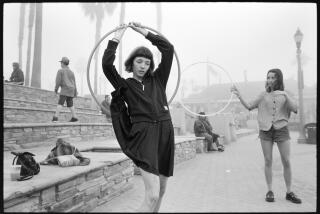SIGHTS AROUND TOWN : Bittersweet Illusion : Photographer Mark Matthews uses the medium of Cibachrome to convey his dark, but paradoxical vision.
Venturan Mark Matthews belongs to the loosely connected group of contemporary photographers with no particular interest in the tight, parasitic relationship that photography has long had with reality. Rather, photography becomes just one step in a conceptual artistic chain.
Matthews’ peculiar Cibachrome images are scenes from an inner world of his own devising, a world where amorphous clay figures are posed in ambiguous settings, usually in archetypal scenarios.
Amorphousness, ambiguity and archetypes are central to Matthews’ aesthetic.
While Matthews’ unique images have been showing up around Ventura County art spaces for the past couple of years (including at the present Assembly of the Arts show at the Ventura Museum), the viewer gets a more complete sense of what he’s up to by visiting “Personal Myths,” his one-man show at the John Nichols Gallery.
Seeing 31 of the works under one roof ushers the viewer into Matthews’ bittersweet illusory realm.
Matthews uses the medium of Cibachrome, but instead of playing up the potential bright palette of that printing process, he keeps things dark and murky, befitting his paradoxical vision.
At first glance, his characters are generally not as playful as they might seem. Pain, social and spiritual stigma, and mythology come through.
A man is encircled by unfriendly peers in “Judgment,” a picture of claustrophobic persecution. “The Howl” depicts a Munch-like screamer, either expressing existential grief or fearing that the goopy liquid he’s standing in will suck him under.
At times, Matthews also supplies sculpted frames for his pieces, further distancing the work from the dictates of pure photography. A 3-D frame with spindly tree branches adds depth illusion to “Forest’s Edge,” in which a slumping figure contemplates a golden orb.
Generally, Matthews’ backgrounds are more than just idle grounds for the figures. A sense of foreboding and mythical torment is apparent in the settings. Or, if the viewer wishes, the settings could be more innocent tableaux.
In “Red Plant,” the red-suffused background could be either a surreal sunset or a landscape in Hedes. “The Crawl” seems to place its lone figure on the precipice of an abyss.
What might have been interpreted as a cozy womb-like setting is betrayed by the title of “Belly of the Whale”--a red man is trapped, stewing in the juices of a leviathan. The homoerotic bedroom scene in “Blue Eclipse” is clammy and clandestine-blue-- rather than joyous.
All of which is not to suggest that “Personal Myths” is merely a dark, joyless trip that relishes its contextual trickery.
There is a self-conscious disparity between the childlike clay scenes and the uglier undercurrents of the imagery. But the sheer from-the-ground-up inventiveness of Matthews’ pictures elicits a deeper response from viewers willing to look beyond the pale.
Matthews deals with soiled innocence, but also conveys the zest of creative energy in his work. Fantastical and prefabricated, his photographs are like snapshots of a self-imagined nether world. At this fairly mature point in his creation of that world, Matthews offers a convincing chronicle.
He puts the art back in artifice.
100 and Counting
Break out the hats and tooters. Beatrice Wood, the sagacious and salacious Ojai-based ceramist of international renown, had her 100th birthday Wednesday. A sprier and more artistically lucid centenarian you’re not liable to find anywhere.
Just in time for the big 1-0-0 celebration, a new documentary on Wood is having its West Coast premiere Sunday as part of the Santa Barbara International Film Festival, which runs today through March 11.
Written and directed by Tom Neff, “Beatrice Wood: Mama of Dada” is a slick package that carefully details Wood’s illustrious past--her lovers included Marcel Duchamp, and she was the role model for the heroine of “Jules and Jim.” Also of great value are philosophical moments with the irrepressible-yet-unpretentious Wood and scenes of her at work.
Where the film falters is in its occasional new-age veneer and, worse, its awkward, nagging obsession with the Dada aspect of the story. “What is Dada?” the interviewees are repeatedly asked and, predictably, answers varied wildly.
As if to join in on what the filmmakers see as the fun-loving, anything-goes spirit of Dada, the film indulges in scenes of jump-cutting, inverted imagery and raw madcap montage.
These scenes are, presumably, supposed to give us a flavor of Dada. Instead, it looks like the filmmakers have been watching too much MTV, and the hi-jinx tends to trivialize the subject instead of celebrating it.
Whatever its other virtues, in the more intrusive passages, Neff runs up against the persistent problem in documenting the lives of artists, whether in films or books.
What is the proper position for these outside observers? Should it be one of dutiful, reportorial, objective distance? Or should they cross the line and insert their own creative flourishes?
In the case of this film, the former approach would have been advisable. A colorful character like Wood doesn’t need any help in putting across her irreverent joie de vivre.
* WHERE AND WHEN
* “Personal Myths,” Cibachrome photographs by Mark Matthews, through March 31 at John Nichols Gallery, 910 E. Main St., Santa Paula. Information: 525-7804.
* “Beatrice Wood: Mama of Dada,” screening as part of the Santa Barbara International Film Festival, at 11 a.m. Sunday at the Santa Barbara Art Museum, 1130 State St. Information: 689-INFO.
More to Read
The biggest entertainment stories
Get our big stories about Hollywood, film, television, music, arts, culture and more right in your inbox as soon as they publish.
You may occasionally receive promotional content from the Los Angeles Times.










